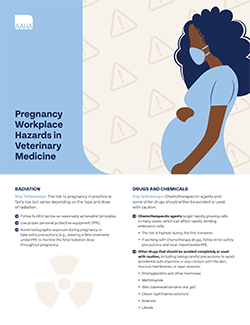HANDOUT: Vet med workplace hazards that can affect pregnancy

When I worked in veterinary practice during my pregnancies, I often wondered about the various hazards I encountered and how much of a risk they posed. I decided to research these topics and write a book so that others would have less uncertainty as they navigate their pregnancies or work with pregnant teammates.
Here were some of my key takeaways about the risks involved with radiation, anesthesia, infectious disease, drugs and chemicals, potential injuries, and—the hardest hazard of all to avoid—stress.
Click to Download: Printable Handout for
|
Radiation
Studies have suggested that, in some cases, exposure of the embryo or fetus to radiation can result in spontaneous abortion or birth defects. The risk to pregnancy varies greatly depending on the type and dose of radiation.
Here’s the good news: Advances in radiographic equipment and a better understanding of ways to lower the radiation doses used have greatly reduced the risk of being exposed to enough radiation to harm a pregnancy.
Nevertheless, it is essential that all personnel follow ALARA (as low as reasonably achievable) principles to lower their radiation dose and use proper personal protective equipment (PPE). Many people choose to completely avoid radiographic exposure during pregnancy.
Those who choose to continue performing tasks that expose them to radiation during their pregnancy must take extra precautions, including wearing a fetal dosimeter underneath their PPE to monitor the fetal radiation dose throughout pregnancy.
Anesthesia
Early studies suggested an increased risk of pregnancy loss and birth defects with exposure during pregnancy to occupational waste anesthetic gas (WAG). However, these were small retrospective studies, not standardized or controlled, that primarily were conducted before the routine use of scavenging equipment now common in human and veterinary hospitals.
We now know that the proper use of a working scavenger reduces the risks associated with WAG exposure by up to 90%.
Still, preventive steps can be taken, such as regularly checking the entire anesthesia circuit for leaks, and avoiding situations where exposure to large doses of WAG might occur, such as:
- Intubating
- Extubating
- Mask or chamber inductions
- Disconnecting the patient from the anesthesia machine frequently
- Spending time recovering the patient from anesthesia
For extra protection, pregnant individuals may choose to wear an organic vapor respirator while working around inhalant anesthetics.
Infectious diseases
The most commonly known infectious disease that poses a threat to pregnancy in humans is toxoplasmosis. However, handling and treating cats is not considered to put veterinary professionals at increased risk because infected cats only shed oocysts intermittently, and those oocysts take at least 24 to 48 hours to become infective after a cat has defecated.
As long as veterinary personnel practice regular hand washing, their risk of occupational exposure to this organism is very low.
However, other infectious organisms such as Brucella spp., Listeria monocytogenes, and Coxiella burnetii (Q Fever) can cause spontaneous abortions in various animal species and in humans as well.
It is therefore recommended that individuals who are or could be pregnant exercise extreme caution or ideally avoid all contact completely with animals who have recently experienced a spontaneous abortion or who are otherwise suspected of having one of these infections.
Drugs and chemicals
Exposure to some drugs and chemicals may pose a risk to the health and safety of a veterinary professional’s pregnancy.
Chemotherapeutic agents target rapidly growing cells in many cases, which can affect rapidly dividing embryonic cells. The risk is highest during the first trimester of pregnancy. Any veterinary professionals who continue to work with chemotherapy drugs during pregnancy must follow strict safety precautions including wearing impermeable PPE.
Other drugs that can pose a risk include:
- Prostaglandins and other hormones
- Methimazole
- Sileo (dexmedetomidine oral gel)
- Clevor (ophthalmic solution)
- Solensia
- Librela
The manufacturers of many of these drugs recommend that individuals who are pregnant or who could be pregnant avoid contact entirely. If pregnant people elect to handle these drugs, it’s important to take careful precautions to avoid accidental auto-injection or any contact with the skin, mucous membranes, or open wounds.
Injuries and ergonomic hazards
The risk of injury is often present in veterinary practice. The most common types of injuries include falls, bites, scratches, and needlestick injuries.
Other types of injuries can include crushing, kicking, trampling, cutting, and automobile injuries. Most injuries will not cause an adverse pregnancy outcome, but the risk is always there. Even minor injuries and ergonomic stresses such as lifting, bending, and standing or sitting for long periods of time can contribute to increased pain and other pregnancy complications.
Many of the injury avoidance principles during pregnancy are the same as those recommended for all personnel.
They include:
- Using proper physical and chemical restraint
- Practicing Fear Free techniques
- Using caution when recapping needles
- Always wearing a seatbelt
Pregnant people should take extra precautions to avoid falls, use careful patient selection, and make efforts to avoid sitting or standing for long periods of time without taking breaks.
Stress and fatigue
Some studies have shown that severe stress can affect fertility and increase the risk of adverse pregnancy events such as pregnancy loss and preterm labor.
Working multiple overnight shifts per week or switching from day to night shifts throughout pregnancy can increase the risk of complications. Even when the pregnancy is unaffected, stress and fatigue can negatively impact a person’s quality of life and ability to continue working.
To reduce the risks, pregnant individuals should be given opportunities throughout the day to sit and rest, to take a walk, or whatever is needed. Where possible, overnight shifts should be reduced or avoided.
Prioritizing sleep—including both overnight sleep and daytime naps—is very important during pregnancy.
Finally, supportive workplace culture and psychological safety are, of course, always helpful to the whole team when it comes to reducing stress.
Whether you are navigating your own pregnancy while working in vet med or you have a pregnant team member to support, I hope this information reassures you that there are ways to mitigate many risks by following recommended safety precautions.
Every case is different, however, so use this as a starting point to make informed decisions that are right for you based on your specific needs and the guidance of your own healthcare providers.
For more of what I have learned about some of the most common workplace hazards in veterinary medicine, check out my book, Pregnancy and Postpartum Considerations for the Veterinary Team.
Emily Singler, VMD, is AAHA’s Veterinary Content Specialist and author of Pregnancy and Postpartum Considerations for the Veterinary Team.
Cover photo credit: ©Marcela Vieira E+ via Getty Images Plus
Disclaimer: The views expressed, and topics discussed, in any NEWStat column or article are intended to inform, educate, or entertain, and do not represent an official position by the American Animal Hospital Association (AAHA) or its Board of Directors.
NEWStat Interesting/unusual Columnists Patient care Practice management




